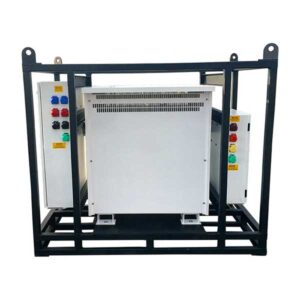What is the purpose of a transformer?
Transformers are found everywhere Alternating Current (AC) electrical energy is used. A transformer is an electrical device that trades voltage for current in a circuit, while not affecting the total electrical power. This means it takes high-voltage electricity with a small current and changes it into low-voltage electricity with a large current, or vice versa. One thing to know about transformers is that they only work for Alternating Current (AC), such as you get from your wall plugs, not Direct Current (DC).
 Step-Up & Step-Down Transformers
Step-Up & Step-Down Transformers
Transformers can be used either to increase or decrease voltage. The transformers designed to convert low voltage to high voltage, also known as stepping up the voltage, are called “step-up transformers.” Ones designed to reduce voltage, also known as stepping down the voltage, are called “step-down transformers.” You can read more about the differences between step-up and step-down transformers here.
How Electrical Transformers Work
Transformers use two coils of wire, each with hundreds or thousands of turns, wrapped around a metal core. One coil is for the incoming electricity and one is for the outgoing electricity. Alternating Current in the incoming coil sets up an alternating magnetic field in the core, which then generates Alternating Current in the outgoing coil.
Energy is lost in the process of transmitting electricity long distances, such as during the journey from a power plant to your home. Less energy is lost if the voltage is very high. Usually, electrical utilities use high voltage in long-distance transmission wires. However, this high voltage is too dangerous for home use. In the case of electrical utilities in homes, they use transformers to change the voltage of electricity as it travels from the power plant to your home.
First using a transformer, the voltage of electricity coming from a power plant is “stepped up” to the right level for long-distance transmission. Because high-voltage current can arc, step up transformers called ignition coils are used to power spark plugs. Dynamos at power plants generate large currents but not a lot of voltage. This electricity is stepped up to high voltage for transmission over wires, as electricity travels more efficiently at high voltage.
Later, the voltage is stepped down before it enters your home – once again using transformers. A “step-down” transformer changes the 440-volt electricity in power lines to the 120-volt electricity you use in your house. Then, the current is either used at that level for devices like light bulbs, or it is converted to DC using an AC/DC adapter for devices like laptop computers.
Since the emergence of the first constant-potential transformers in 1885, transformers have become essential for the transmission, distribution, and utilization of Alternating Current electrical energy in all applications of power.
Types of Transformers for Commercial & Industrial Projects
When mapping an electrical system, there are two main types of transformers you can encounter: power and distribution. Power transformers are typically used for utility power at power plants for networks in cities, so unless you are transmitting electrical energy at a heavy load with voltage higher than 33 KV and 100% efficiency, you will likely need a distribution transformer.
Found on many temporary jobsites, distribution transformers are often used to convert power from an on-site generator to a secondary voltage for powering tools, lighting, and other equipment. If you’re not sure what type your project needs, read about power transformer vs distribution transformers.
Portable Transformers for Temporary Power Solutions
Portable transformers are designed to be lightweight and compact, making them easy to transport and set up in different locations as needed. These transformers are used to reduce, increase, or clean existing voltage to provide electrical power to various equipment for different industry applications.
For instance, a step-down portable transformer could be used on construction sites to convert high voltage power from a large generator to a lower voltage suitable for powering tools and lighting where access to a nearby power source is not available. A portable step-up transformer may be used on jobsites to power equipment that requires a higher voltage than what is available from the local power grid.
Portable transformers are used to power lighting and sound systems for events and concerts in outdoor locations or venues that do not have adequate electrical infrastructure. Film and TV production companies use transformers for lights and camera equipment on location shoots where there may not be access to an electrical outlet. Overall, portable transformers are useful in any situation where electrical power needs to be transformed or distributed in a temporary or mobile setting.
At Power Temp Systems, we specialize in making innovative equipment that efficiently and safely distributes and utilizes power for any project. Contact us to discuss your power needs.
